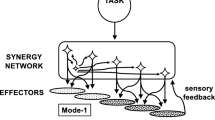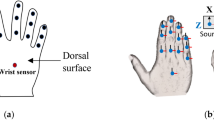Abstract
When people move, they organize large, abundant sets of elements (limbs, joints, digits, muscles, motor units, etc.) in a task–specific way by the central nervous system. Such organizations (synergies) ensure action stability, which is crucial given the varying internal body states and external forces. Action stability is controlled in a task-specific way. In particular, stability is reduced in a feed-forward manner (anticipatory synergy adjustment, ASA) if a person plans to perform a quick change of a salient performance variable. The importance of controlled stability for everyday movements is exemplified by studies of neurological patients who show deficits in both aspects of controlled stability: reduced stability during steady-state actions and small/delayed ASAs in preparation to a quick action. The physical approach to movement synergies has been developed using two theoretical frameworks. One of them is the idea of control with spatial referent coordinates (RCs) for salient variables. The other is the idea of intention-specific stability of redundant systems developed within the uncontrolled manifold (UCM) hypothesis. The RC and UCM hypotheses have been united into a single theory incorporating the idea of hierarchical control. This theory is able to account for results of a variety of studies that used perturbations of ongoing movements, analysis of variance across repetitive trials, and analysis of motor equivalence. Recent studies have provided links of this theory to neurophysiological structures and provide tools sensitive to impaired stability and agility of movements in patients with various neurological disorders.
Access this chapter
Tax calculation will be finalised at checkout
Purchases are for personal use only
Similar content being viewed by others
References
Ambike, S., Mattos, D., Zatsiorsky, V.M., Latash, M.L.: Unsteady steady-states: central causes of unintentional force drift. Exp. Brain Res. 234, 3597–3611 (2016)
Babikian, S., Kanso, E., Kutch, J.J.: Cortical activity predicts good variation in human motor output. Experimental Brain Research (2017) (e-pub https://doi.org/10.1007/s00221-017-4876-9)
Bastian, A.J., Martin, T.A., Keating, J.G., Thach, W.T.: Cerebellar ataxia: abnormal control of interaction torques across multiple joints. J. Neurophysiol. 76, 492–509 (1996)
Belenkiy, V.Y., Gurfinkel, V.S., Pal’tsev, Y.I.: Elements of control of voluntary movements. Biofizika 10, 135–141 (1967)
Bernstein, N.A.: A new method of mirror cyclographie and its application towards the study of labor movements during work on a workbench. Hygiene, Safety and Pathology of Labor, # 5, pp. 3–9, and # 6, pp. 3–11 (1930) (in Russian)
Bernstein, N.A.: The problem of interrelation between coordination and localization. Arch. Biol. Sci. 38, 1–35 (1935). (in Russian)
Bernstein, N.A.: On the Construction of Movements. Medgiz, Moscow (1947). (in Russian)
Bernstein, N.A.: The Co-ordination and Regulation of Movements. Pergamon Press, Oxford (1967)
Bobath, B.: Adult Hemiplegia: Evaluation and Treatment. William Heinemann, London (1978)
Danna-Dos-Santos, A., Slomka, K., Zatsiorsky, V.M., Latash, M.L.: Muscle modes and synergies during voluntary body sway. Exp. Brain Res. 179, 533–550 (2007)
d’Avella, A., Saltiel, P., Bizzi, E.: Combinations of muscle synergies in the construction of a natural motor behavior. Nat. Neurosci. 6, 300–308 (2003)
DeWald, J.P., Pope, P.S., Given, J.D., Buchanan, T.S., Rymer, W.Z.: Abnormal muscle coactivation patterns during isometric torque generation at the elbow and shoulder in hemiparetic subjects. Brain 118, 495–510 (1995)
Diedrichsen, J., Shadmehr, R., Ivry, R.B.: The coordination of movement: optimal feedback control and beyond. Trends Cogn. Sci. 14, 31–39 (2010)
Falaki, A., Huang, X., Lewis, M.M., Latash, M.L.: Impaired synergic control of posture in Parkinson’s patients without postural instability. Gait Posture 44, 209–215 (2016)
Feldman, A.G.: Functional tuning of the nervous system with control of movement or maintenance of a steady posture. II Controllable parameters of the muscle. Biophysics 11, 565–578 (1966)
Feldman, A.G.: Central and Reflex Mechanisms of Motor Control. Nauka, Moscow (in Russian) (1979)
Feldman, A.G.: Once more on the equilibrium-point hypothesis (λ-model) for motor control. J. Mot. Behav. 18, 17–54 (1986)
Feldman, A.G., Orlovsky, G.N.: The influence of different descending systems on the tonic stretch reflex in the cat. Exp. Neurol. 37, 481–494 (1972)
Hoehn, M., Yahr, M.: Parkinsonism: onset, progression and mortality. Neurology 17, 427–442 (1967)
Jerde, T.E., Soechting, J.F., Flanders, M.: Coarticulation in fluent fingerspelling. J. Neurosci. 23, 2383–2393 (2003)
Jo, H.J., Maenza, C., Good, D.C., Huang, X., Park, J., Sainburg, R.L., Latash, M.L.: Effects of unilateral stroke on multi-finger synergies and their feed-forward adjustments. Neuroscience 319, 194–205 (2016)
Jo, H.J., Lucassen, E., Huang, X., Latash, M.L.: Changes in multi-digit synergies and their feed-forward adjustments in multiple sclerosis. J. Mot. Behav. 49, 218–228 (2017)
Johansson, R.S., Westling, G.: Roles of glabrous skin receptors and sensorimotor memory in automatic control of precision grip when lifting rougher or more slippery objects. Exp. Brain Res. 56, 550–564 (1984)
Klous, M., Danna-dos-Santos, A., Latash, M.L.: Multi-muscle synergies in a dual postural task: evidence for the principle of superposition. Exp. Brain Res. 202, 457–471 (2010)
Krishnamoorthy, V., Goodman, S.R., Latash, M.L., Zatsiorsky, V.M.: Muscle synergies during shifts of the center of pressure by standing persons: Identification of muscle modes. Biol. Cybern. 89, 152–161 (2003)
Latash, M.L.: Synergy. Oxford University Press, New York (2008)
Latash, M.L.: Towards physics of neural processes and behavior. Neurosci. Biobehav. Rev. 69, 136–146 (2016)
Latash, M.L., Scholz, J.F., Danion, F., Schöner, G.: Structure of motor variability in marginally redundant multi-finger force production tasks. Exp. Brain Res. 141, 153–165 (2001)
Latash, M.L., Shim, J.K., Smilga, A.V., Zatsiorsky, V.: A central back-coupling hypothesis on the organization of motor synergies: a physical metaphor and a neural model. Biol. Cybern. 92, 186–191 (2005)
Latash, M.L., Huang, X.: Neural control of movement stability: lessons from studies of neurological patients. Neuroscience 301, 39–48 (2015)
Latash, M.L., Zatsiorsky, V.M.: Joint stiffness: myth or reality? Hum. Mov. Sci. 12, 653–692 (1993)
Latash, M.L., Zatsiorsky, V.M.: Biomechanics and Motor Control: Defining Central Concepts. Academic Press, New York, NY (2016)
Lewis, M.M., Lee, E.-Y., Jo, H.J., Park, J., Latash, M.L., Huang, X.: Synergy as a new and sensitive marker of basal ganglia dysfunction: a study of asymptomatic welders. Neurotoxicology 56, 76–85 (2016)
Liddell, E.G.T., Sherrington, C.S.: Reflexes in response to stretch (myotatic reflexes). Proc. R. Soc. Lond., Series B 96, 212–242 (1924)
Loeb, G.E.: What might the brain know about muscles, limbs and spinal circuits? Prog. Brain Res. 123, 405–409 (1999)
Martin, V., Scholz, J.P., Schöner, G.: Redundancy, self-motion, and motor control. Neural Comput. 21, 1371–1414 (2009)
Massion, J.: Movement, posture and equilibrium–interaction and coordination. Prog. Neurobiol. 38, 35–56 (1992)
Matthews, P.B.C.: The dependence of tension upon extension in the stretch reflex of the soleus of the decerebrate cat. J. Physiol. 47, 521–546 (1959)
Mattos, D., Latash, M.L., Park, E., Kuhl, J., Scholz, J.P.: Unpredictable elbow joint perturbation during reaching results in multijoint motor equivalence. J. Neurophysiol. 106, 1424–1436 (2011)
Mattos, D., Kuhl, J., Scholz, J.P., Latash, M.L.: Motor equivalence (ME) during reaching: is ME observable at the muscle level? Mot. Control 17, 145–175 (2013)
Mattos, D., Schöner, G., Zatsiorsky, V.M., Latash, M.L.: Motor equivalence during accurate multi-finger force production. Exp. Brain Res. 233, 487–502 (2015)
Olafsdottir, H., Yoshida, N., Zatsiorsky, V.M., Latash, M.L.: Anticipatory covariation of finger forces during self-paced and reaction time force production. Neurosci. Lett. 381, 92–96 (2005)
Park, J., Jo, H.J., Lewis, M.M., Huang, X., Latash, M.L.: Effects of Parkinson’s disease on optimization and structure of variance in multi-finger tasks. Exp. Brain Res. 231, 51–63 (2013)
Park, J., Lewis, M.M., Huang, X., Latash, M.L.: Dopaminergic modulation of motor coordination in Parkinson’s disease. Parkinsonism Relat. Disord. 20, 64–68 (2014)
Park, J., Wu, Y.-H., Lewis, M.M., Huang, X., Latash, M.L.: Changes in multi-finger interaction and coordination in Parkinson’s disease. J. Neurophysiol. 108, 915–924 (2012)
Parsa, B., O’Shea, D.J., Zatsiorsky, V.M., Latash, M.L.: On the nature of unintentional action: a study of force/moment drifts during multi-finger tasks. J. Neurophysiol. 116, 698–708 (2016)
Parsa, B., Zatsiorsky, V.M., Latash, M.L.: Optimality and stability of intentional and unintentional actions: II. Motor equivalence and structure of variance. Exp. Brain Res. 235, 457–470 (2017)
Prilutsky, B.I., Zatsiorsky, V.M.: Optimization-based models of muscle coordination. Exerc. Sport Sci. Rev. 30, 32–38 (2002)
Pruszynski, J.A., Scott, S.H.: Optimal feedback control and the long-latency stretch response. Exp. Brain Res. 218, 341–359 (2012)
Reisman, D., Scholz, J.P.: Aspects of joint coordination are preserved during pointing in persons with post-stroke hemiparesis. Brain 126, 2510–2527 (2003)
Reisman, D.S., Scholz, J.P.: Workspace location influences joint coordination during reaching in post-stroke hemiparesis. Exp. Brain Res. 170, 265–276 (2006)
Sainburg, R.L., Ghilardi, M.F., Poizner, H., Ghez, C.: Control of limb dynamics in normal subjects and patients without proprioception. J. Neurophysiol. 73, 820–835 (1995)
Santello, M., Bianchi, M., Gabiccini, M., Ricciardi, E., Salvietti, G., Prattichizzo, D., Ernst, M., Moscatelli, A., Jörntell, H., Kappers, A.M., Kyriakopoulos, K., Albu-Schäffer, A., Castellini, C., Bicchi, A.: Hand synergies: Integration of robotics and neuroscience for understanding the control of biological and artificial hands. Phys. Life Rev. 17, 1–23 (2016)
Scholz, J.P., Schöner, G., Hsu, W.L., Jeka, J.J., Horak, F., Martin, V.: Motor equivalent control of the center of mass in response to support surface perturbations. Exp. Brain Res. 180, 163–179 (2007)
Scholz, J.P., Danion, F., Latash, M.L., Schöner, G.: Understanding finger coordination through analysis of the structure of force variability. Biol. Cybern. 86, 29–39 (2002)
Scholz, J.P., Reisman, D., Schoner, G.: Effects of varying task constraints on solutions to joint coordination in a sit-to-stand task. Exp. Brain Res. 141, 485–500 (2001)
Scholz, J.P., Schöner, G.: The uncontrolled manifold concept: identifying control variables for a functional task. Exp. Brain Res. 126, 289–306 (1999)
Schöner, G.: Recent developments and problems in human movement science and their conceptual implications. Ecol. Psychol. 8, 291–314 (1995)
Shim, J.K., Latash, M.L., Zatsiorsky, V.M.: The central nervous system needs time to organize task-specific covariation of finger forces. Neurosci. Lett. 353, 72–74 (2003)
Shim, J.K., Olafsdottir, H., Zatsiorsky, V.M., Latash, M.L.: The emergence and disappearance of multi-digit synergies during force production tasks. Exp. Brain Res. 164, 260–270 (2005)
Todorov, E.: Optimality principles in sensorimotor control. Nat. Neurosci. 7, 907–915 (2004)
Todorov, E., Jordan, M.I.: Optimal feedback control as a theory of motor coordination. Nat. Neurosci. 5, 1226–1235 (2002)
Todorov, E.: Efficient computation of optimal actions. Proc. Natl. Acad. Sci. 106, 11478–11483 (2009)
Author information
Authors and Affiliations
Corresponding author
Editor information
Editors and Affiliations
Rights and permissions
Copyright information
© 2019 Springer International Publishing AG, part of Springer Nature
About this chapter
Cite this chapter
Latash, M.L. (2019). Human Movements: Synergies, Stability, and Agility. In: Venture, G., Laumond, JP., Watier, B. (eds) Biomechanics of Anthropomorphic Systems. Springer Tracts in Advanced Robotics, vol 124. Springer, Cham. https://doi.org/10.1007/978-3-319-93870-7_7
Download citation
DOI: https://doi.org/10.1007/978-3-319-93870-7_7
Published:
Publisher Name: Springer, Cham
Print ISBN: 978-3-319-93869-1
Online ISBN: 978-3-319-93870-7
eBook Packages: Intelligent Technologies and RoboticsIntelligent Technologies and Robotics (R0)




